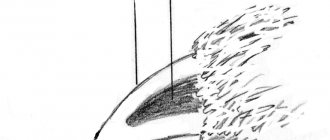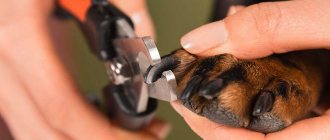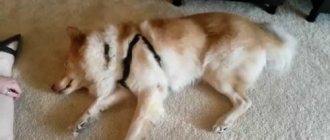It is said that King Solomon had a ring that allowed its owner to understand animals. Of course, anyone who has been around dogs for any length of time will tell you that dogs don't need human words to express their feelings. Head tilt, tail angle; each conveys volumes of information to a person. A dog doesn't need simple words when his whole body speaks for him. However, communication does not depend solely on tail wagging and ear position.
A dog is a symphony of sounds. Every bark, whine and snort speaks to its owners. But one of the strangest sounds is grunting. Your dog suddenly sounds like a truffle pig on the hunt. Maybe this is normal behavior and your dog is grumbling during dinner. Maybe your dog makes a strange grunt when he goes to bed. Whatever the circumstances, you are the best source of information about whether this behavior is cute or strangely disturbing.
The Root of Behavior
So why do dogs groan? In most cases, a dog's grunting is an involuntary expression of satisfaction. Dogs grunt when they are relaxed. Puppies will grunt along with their littermates and while feeding. Adult dogs often grunt when petted. A lapdog may grumble while relaxing on the couch with his people. Dogs often grunt when they turn away from a stressful situation, such as a visit to the vet. According to veterinary behaviorist Dr. Benjamin Hart of the University of California, Davis School of Veterinary Medicine, dogs often make quiet grunts while sleeping.
Some dogs will grunt more than others. Dog breeds with a flat face are called brachycephalic breeds. Breeds such as Pugs, Bulldogs, Chow Chows and Pekingese have longer soft palates and narrow nasal passages, so they tend to grunt more than other dogs. Because of their facial shape, they are more susceptible to heat stroke and other illnesses. In fact, it has prompted the British Veterinary Association to urge people to stop buying such breeds. In the United States, many major airlines have imposed restrictions on the carriage of short-nosed breeds in their cargo holds; some refused to transport them as cargo at all under certain conditions.
© shutterstock
In addition to natural grumbling, sometimes a dog's grumbling can indicate health problems. For example, an older dog may grunt when going up and down stairs, or may grunt when going to bed or getting up from sleep. This grunting may indicate arthritis, especially when the dog is reluctant to go for a walk. Dogs may also grunt due to gastrointestinal problems such as swallowing while eating. Swallowing food can cause bloating, a life-threatening condition that can lead to stomach dislocation.
Panosteitis, or puppy growing pains.
Growing pains, or panosteitis, can be as severe in puppies as they are in children. This is especially true for large dog breeds. Also known as pano in dogs, it is an uncomfortable and painful condition that occurs when a puppy's bones grow faster than they can easily adapt.
Moaning and moaning while lying down is one of the ways he expresses discomfort. A dog's growling is the least noticeable symptom of this condition. You are more likely to see your puppy limping or favoring one leg over the other. He will also scream or scream if you touch his sensitive leg.
This problem can affect all puppies, especially German Shepherds, until they are fully grown or reach 2 years of age. One good thing about growing pains is that they end when the growth does.
Encouraging behavior
Of course, no one knows your dog better than you. If a dog that doesn't grunt often suddenly starts grunting, you should visit your veterinarian to rule out or treat any underlying conditions. As always, share your concerns and observations with your veterinarian so he can make a full assessment. But unless there is a serious medical problem, most of the time, dog grumbling is nothing to worry about. If no medical cause is found, your dog is most likely simply expressing contentment and happiness. Pay close attention and try to understand what you are doing that makes her grunt. Maybe she likes to bring you the ball you tossed; maybe she likes to catch frisbees. Or maybe she just loves a nice long walk or a helping of her favorite food. Or maybe she just likes to curl up on the couch and watch TV—or take a nap with her significant other. Find out what makes your furry friend happy and do more of it. Family, work and everyday life in general are full of complex and difficult people. What a great way to spend a little time just getting your dog to make happy, ferocious noises!
Howl
Why do dogs often howl when their owners are away? They call them home! They inherited the ability to howl from their ancestors - wolves. With his howl, the wolf tells the members of the pack where he is. Dogs also call their owners home. Also, the howl can also mean a warning for other animals, which the dog forbids in this way to enter its territory.
The dog will also howl to warn of danger, for example, if it hears the siren of a fire truck.
Other solutions and considerations
So you've observed your dog, you've talked to your veterinarian, and his grumbling is not the result of any medical problem. However, even then, you will sometimes find that your dog's grumbling is disturbing or alarming. What can you do to minimize this behavior?
Take time to think about what is going on before your dog starts grunting. Do you lift her up with your hand under her chest and perhaps accidentally force her to exhale? Should you change her feeding schedule, perhaps feeding her smaller meals more often?
NOTE : Feeding your dog smaller meals more often also helps prevent bloat! There may be steps you can take to minimize the stressful situations that cause her to grunt while resting. As with all aspects of life with a dog, understanding is the key to harmony.
So why do dogs groan? This unconscious behavior is usually a good sign and sometimes a worrying one. All dogs grunt, some more than others. This is part of the amazing variety of sounds our dogs make. The dog uses his entire body to express his feelings and desires, eliminating the need for words. After all, who wants to hear an animal say, “I love you,” when it expresses it with its entire body?
How can I tell my dog that I love him?
5 Ways to Tell Your Dog You Love Him in His Native Language
- Training and positive reinforcement. A great way to express your love is through positive reinforcement. ...
- Read to your dog. Do you read to your children before bed? ...
- Give a human touch. ...
- Engage in deep conversations. ...
- Rub your dog's ears.
THIS IS INTERESTING: Question: Are drug dogs trained to take certain medications?
8.02.2019
Many of the ways your dog talks to you leaves you in the dark.
The behavior of our dogs does not always make sense to us, but our behavior does not always make sense to them.
But unlike you and me, dogs depend on people for everything. In addition, there is a “language barrier” between people and dogs. While we communicate with each other through words, dogs communicate in a variety of other ways. That's why it's incredibly helpful for dog owners to understand what their dog is telling them.
The more you understand how your animal understands its world, the less likely you are to become frustrated or angry. And the less unfairly you will treat him. And, ultimately, the better and stronger the connection between the two of you will be.
And this is true for all animal owners: for those who have their first dog in their life; and for those who have always lived with a pet. Our younger brothers are extremely attentive to our emotions, mood, body language, intonation. And the least we can do in return is to show the same interest in their communication.
Reverse breathing
Sometimes dogs can make a buzzing, startling noise, also called a “reverse sneeze.” Hearing this sound may make you think your dog is choking or choking. This is usually a short-term phenomenon and does not pose any danger.
Chinese scientists have discovered which men are the greediest
You can make convenient flower stands from inexpensive photo frames: an easy way
Asymmetrical shoulder-length hair and a few more fashionable medium-length haircuts
Sounds similar to snorting, coughing and gagging at the same time are caused by irritation of the throat and soft palate. This phenomenon may also indicate anxiety, a foreign object in the throat, viruses and allergies. If the sound is not caused by a sharp pull on the leash and occurs frequently, you should consult a veterinarian.
Many of the ways your dog talks to you leaves you in the dark.
The behavior of our dogs does not always make sense to us, but our behavior does not always make sense to them. But unlike you and me, dogs depend on people for everything.
In addition, there is a “language barrier” between people and dogs. While we communicate with each other through words, dogs communicate in a variety of other ways. That's why it's incredibly helpful for dog owners to understand what their dog is telling them.
The more you understand how your animal understands its world, the less likely you are to become frustrated or angry. And the less unfairly you will treat him. And, ultimately, the better and stronger the connection between the two of you will be.
And this is true for all animal owners: for those who have their first dog in their life; and for those who have always lived with a pet. Our younger brothers are extremely attentive to our emotions, mood, body language, intonation. And the least we can do in return is to show the same interest in their communication.
Liver disease in dogs: symptoms
Liver diseases in dogs can occur in acute or chronic form. In recent years, there has been an increase in the number of diagnosed liver diseases in dogs, which is directly related to violations of the feeding regime of pets and the widespread prevalence of autoimmune diseases. Sometimes the cause of liver disease in dogs is iatrogenic lesions (caused by a veterinarian).
Symptoms of liver disease in dogs are conventionally divided into a number of syndromes, among which are usually distinguished:
- cholestatic syndrome;
- cytolytic syndrome;
- mesenchymal inflammatory syndrome;
- hemorrhagic syndrome;
- dyspeptic syndrome;
- portal hypertension syndrome;
- hepatolienal syndrome;
- hepatodepressive syndrome;
- liver shunt syndrome.
Cholestatic syndrome involves a violation of the secretion and release of bile, which is manifested by skin itching, jaundice, a tendency to eczematous skin lesions, and stool discoloration.
Cholestatic syndrome is a consequence of the destruction of liver cells and leads to fever (increased temperature), enlargement and tenderness of the liver, and an increase in liver enzymes is observed in blood tests.
Mesenchymal-inflammatory syndrome is characterized by damage to the stroma and mesenchyme of the liver, which is manifested by an increase in the level of immunoglobulins.
Hemorrhagic syndrome is manifested by various bleedings and hemorrhages, anemia.
Portal hypertension syndrome is manifested by an increase in the size of the abdomen and dilation of the veins on the skin of the abdomen.
Dyspeptic syndrome is manifested by lethargy, depression, vomiting, defecation disorders and weight loss.
Hepatolienal syndrome is manifested by an enlargement of the liver and spleen.
Hepatodepressive syndrome is manifested by a violation of the protein-synthesizing, antitoxic and excretory functions of the liver; the symptoms are very numerous.
Liver shunt syndrome allows life-threatening substances to enter the dog's general bloodstream, causing damage to the central nervous system.
Symptoms of kidney disease in dogs
Kidney diseases are reported more often in dogs than in other animals, and their frequency increases over the years. According to scientists, in dogs over 8 years of age, in almost fifty percent of cases, pronounced symptoms of kidney damage are revealed during studies. With histological examination, the number increases to eighty percent.
The main syndromes of kidney damage include:
- nephrotic syndrome;
- uremic syndrome;
- pain syndrome;
- osteorenal syndrome;
- renal eclampsia syndrome.
Pain syndrome is manifested by the dog's desire to lie in a cold place, frequent arching of the back, the need for frequent urination, pain when urinating, soreness of the back muscles (can be checked by pressing with fingers), swelling and transient paresis.
Nephrotic syndrome is manifested by edema, proteinuria, hypoproteinemia, oliguria and cylindruria, detected during laboratory tests.
Uremic syndrome is manifested by apathy, lack of appetite, vomiting, persistently recurrent diarrhea, urine odor from the mouth, anemia and anuria.
Osteorenal syndrome is characterized by bone deformation and osteoporosis, hypocalcemia and osteodystrophy.
Renal eclampsia syndrome manifests as tonic-clonic seizures, nephrotic syndrome, and episcleral vascular injection (red eyes).
Diagnosis of the condition
If breathing problems are not associated with physiological causes, the owner should not hesitate to visit a specialized institution. A veterinarian will examine the animal’s nasopharynx and provide immediate assistance if the problem is a foreign object.
If polyps or neoplasms in the nasopharynx are suspected, as well as to determine the exact location of a foreign object, a veterinarian conducts an X-ray examination of the furry patient. carried out in direct and lateral projection.
If there is a suspicion that difficulty breathing is associated with problems in the myocardium, the animal is prescribed an electrocardiographic and ultrasound examination of the heart.
Ultrasound of the heart
Diseases of an infectious nature are excluded using bacteriological or virological analysis of biological material.











